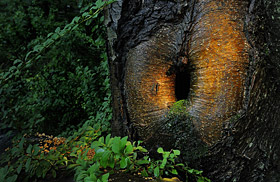 Hi and welcome to this edition of Workshop at the Ranch. Sports event coverage rarely calls for the use of a Graduated Neutral Density Filter. As a result, I had little knowledge of the advantages in stylization one can add to an image until last fall while working in Florida. Many of the industry legends make use of this tool when photographing landscapes and so I decided to once again incorporate the use of a Cokin 3X Graduated Neutral Density Filter while working in the Pocono Mountains of Pennsylvania this summer.
Hi and welcome to this edition of Workshop at the Ranch. Sports event coverage rarely calls for the use of a Graduated Neutral Density Filter. As a result, I had little knowledge of the advantages in stylization one can add to an image until last fall while working in Florida. Many of the industry legends make use of this tool when photographing landscapes and so I decided to once again incorporate the use of a Cokin 3X Graduated Neutral Density Filter while working in the Pocono Mountains of Pennsylvania this summer.
Hi and welcome to this edition of Workshop at the Ranch. Sports event coverage rarely calls for the use of a Graduated Neutral Density Filter. As a result, I had little knowledge of the advantages in stylization one can add to an image until last fall while working in Florida. Many of the industry legends make use of this tool when photographing landscapes and so I decided to once again incorporate the use of a Cokin 3X Graduated Neutral Density Filter while working in the Pocono Mountains of Pennsylvania this summer.
The general idea of using the filter is to decrease the exposure of a particular area of the image while leaving the other area unaffected and exposed normally. For instance, if the scene I want to photograph has a bright sky on the top portion of the frame and the bottom portion is a dark forest, I can bring the exposure of the sky down 3 stops (with a 3X) and more closely match it to the forest. The Cokin filter I use is 4 in. x 4 in. and is 3 stops darker at the top and then gradually lightens for 2 in. and becomes clear for the remaining 2 in. It “gradually” transitions from 3 stops under exposed to mid-way and then becomes perfectly clear to the opposite edge.
Landscape photographers use a graduated neutral density filter to darken the sky over a mountain range, or seascape. I have the Cokin bracket that fits over the front of my 24-70mm lens and my 70-200mm lens (a 72mm filter size). There are four slots to place filters, but I only have one filter at the time of this writing. The filter can easily slide up or down in the filter bracket slot so as to position the 3X graduated portion precisely were I want it along the horizon when mounted vertically. The Cokin bracket can also rotate around your lens which allows you to gradually darken from any edge of the frame you choose. This works well for darkening a side or even a diagonol transition. This technique can help stylize your images which draws attention to your pictures. Let’s have a look at some of the work I did in the Poconos.
|
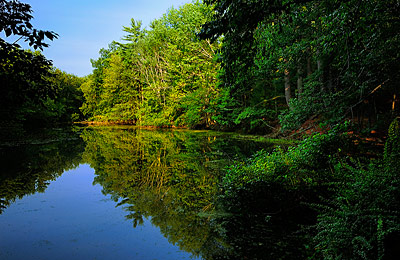 Image #1 Forest Reflection … The grounds that I was working on are beautiful and super lush thanks to heavy rains during the summer season. The left side of the frame has the darker portion of the filter. The 3 stops darker begins at the left edge of the frame and gradually fades to clear at the middle and continues perfectly clear to the right edge of the frame. Originally the sunlit trees and sky were far too bright and so I used the filter to hold the exposure down so that I can also see detail in the darker forest area that has no sunshine on it. The filter reduces the exposure on the left side and allows me to see detail in the sky, deepen the blue of the lake, yet the clear side allows me to see the details of the dense forest. As there was no sunshine illuminating the bushes on the right I used two Nikon SB-900 Speedlights to “spill” some light on them in order to help balance the scene. Nikon D3x, ISO250, 1/6 at f22, Nikon 24-70mm lens with Cokin 3X Graduated Neutral Density Filter from left to right, Two Nikon SB-900 Speedlights at power output of +2.0, Nikon SU-800 Commander, Gitzo Carbon Fiber Tripod and Ball Head with Kirk “L” Bracket, Lexar 16G Flash Card. Image #1 Forest Reflection … The grounds that I was working on are beautiful and super lush thanks to heavy rains during the summer season. The left side of the frame has the darker portion of the filter. The 3 stops darker begins at the left edge of the frame and gradually fades to clear at the middle and continues perfectly clear to the right edge of the frame. Originally the sunlit trees and sky were far too bright and so I used the filter to hold the exposure down so that I can also see detail in the darker forest area that has no sunshine on it. The filter reduces the exposure on the left side and allows me to see detail in the sky, deepen the blue of the lake, yet the clear side allows me to see the details of the dense forest. As there was no sunshine illuminating the bushes on the right I used two Nikon SB-900 Speedlights to “spill” some light on them in order to help balance the scene. Nikon D3x, ISO250, 1/6 at f22, Nikon 24-70mm lens with Cokin 3X Graduated Neutral Density Filter from left to right, Two Nikon SB-900 Speedlights at power output of +2.0, Nikon SU-800 Commander, Gitzo Carbon Fiber Tripod and Ball Head with Kirk “L” Bracket, Lexar 16G Flash Card.
|
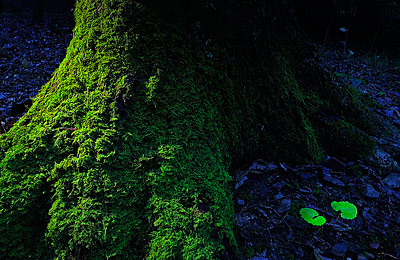 Image #2 Old Growth New Growth … Image #2 Old Growth New Growth … With this image I rotated the filter and positioned it diagonally across the frame. The 3x darker portion begins in the upper right corner and gradually fades to clear at the center and then continues clear to the lower left corner. I used a very cool/blue WB of 2500K to blue the shadows and then illuminated the mossy tree and new plant life with two SB-900 Speedlights, each with the warming gel. I used a LumiQuest Snoot to spotlight the new plant in the lower right corner. Nikon D2x, ISO100, 2 seconds at f22, Nikon 24-70mm lens with Cokin 3X Graduated Neutral Density Filter from upper right to lower left, WB 2500K Two Nikon SB-900 Speedlights each with Warming Gel and power output of +3.0, Nikon SU-800 Commander, Gitzo Carbon Fiber Tripod and Ball Head with Kirk “L” Bracket, Lexar 16G Flash Card. |
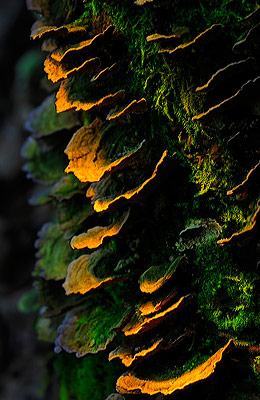 Image #3 Forest Steps … This image has the filter rotated to the left with the 3X darker portion beginning on the left edge and slightly rotated to match the diagonal line of the illuminated fungus. I also lessened the darkened left side of the scene by pulling the filter to the left so that the graduated portion is more like 2X and then fades to clear until the right side of the frame. The Cokin filter bracket allows you to slide the filter laterally. Nikon D3x, ISO500, 2 seconds at f22, Nikon 105 Micro lens with Cokin 3X Graduated Neutral Density Filter slightly angled from left to right, WB 5560K, INOVA XO3 LED Flashlight, Gitzo Carbon Fiber Tripod and Ball Head with Kirk “L” Bracket, Lexar 16G Flash Card. This is a Lightpainting with a 2 second exposure time. A flashlight can be very useful when making small daytime Lightpaintings when your subject is in deep shade. The Nikon Micro lens is smaller diamiter than the 24-70mm lens so the Cokin bracket did not fit, but I just hand held the filter over the front of the lens. It worked fine, but I plan on purchasing a ring that will attach to the 105 Micro and hold the Cokin Bracket with filter in place. Image #3 Forest Steps … This image has the filter rotated to the left with the 3X darker portion beginning on the left edge and slightly rotated to match the diagonal line of the illuminated fungus. I also lessened the darkened left side of the scene by pulling the filter to the left so that the graduated portion is more like 2X and then fades to clear until the right side of the frame. The Cokin filter bracket allows you to slide the filter laterally. Nikon D3x, ISO500, 2 seconds at f22, Nikon 105 Micro lens with Cokin 3X Graduated Neutral Density Filter slightly angled from left to right, WB 5560K, INOVA XO3 LED Flashlight, Gitzo Carbon Fiber Tripod and Ball Head with Kirk “L” Bracket, Lexar 16G Flash Card. This is a Lightpainting with a 2 second exposure time. A flashlight can be very useful when making small daytime Lightpaintings when your subject is in deep shade. The Nikon Micro lens is smaller diamiter than the 24-70mm lens so the Cokin bracket did not fit, but I just hand held the filter over the front of the lens. It worked fine, but I plan on purchasing a ring that will attach to the 105 Micro and hold the Cokin Bracket with filter in place.
|
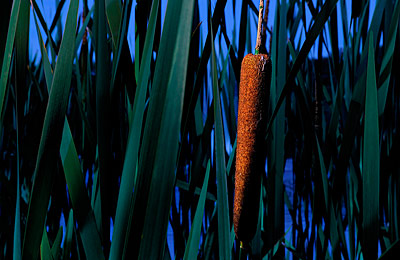 Image #4 Lake Reed … Sometimes the simplest of imagery can be very effective. Here is the classic Moody Blue Formula (cool/blue 3030K WB and single Speedlight with Warming Gel illuminating the subject, a lake reed. This image was made at 11:00 am under cloudless/sunny Pocono Mountain skies. I used the Cokin 3X Graduated Neutral Density Filter to reduce the exposure on the top 1/3 of the image (the sky and gray stem of the reed. Now the sky exposure matches the lake water exposure, and thanks to the cool/blue WB of 3030K both sky and lake are a deep cobalt blue. This WB also makes the green leafs and reed a cool blue as well, but by using one Nikon SB-900 Speedlight with the Warming Gel and a LumiQuest Snoot I have singled out the reed by illuminating it with warm light. Nikon D3x, ISO500, 1/200 at f14, Nikon 24-70mm lens with Cokin 3X Graduated Neutral Density Filter, WB 3030K, One Nikon SB-900 Speedlight with warming gel and a power output of +2.0 and a LumiQuest Snoot, Nikon SU-800 Commander, Lexar 16G Flash Card. Image #4 Lake Reed … Sometimes the simplest of imagery can be very effective. Here is the classic Moody Blue Formula (cool/blue 3030K WB and single Speedlight with Warming Gel illuminating the subject, a lake reed. This image was made at 11:00 am under cloudless/sunny Pocono Mountain skies. I used the Cokin 3X Graduated Neutral Density Filter to reduce the exposure on the top 1/3 of the image (the sky and gray stem of the reed. Now the sky exposure matches the lake water exposure, and thanks to the cool/blue WB of 3030K both sky and lake are a deep cobalt blue. This WB also makes the green leafs and reed a cool blue as well, but by using one Nikon SB-900 Speedlight with the Warming Gel and a LumiQuest Snoot I have singled out the reed by illuminating it with warm light. Nikon D3x, ISO500, 1/200 at f14, Nikon 24-70mm lens with Cokin 3X Graduated Neutral Density Filter, WB 3030K, One Nikon SB-900 Speedlight with warming gel and a power output of +2.0 and a LumiQuest Snoot, Nikon SU-800 Commander, Lexar 16G Flash Card.
|
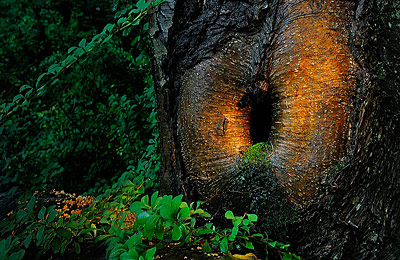 Image #5 Knot Hole … I made over twenty landscapes and and small forest scenes using the Cokin 3X Graduated Neutral Density Filter and liked them all, but I believe this one is my favorite. The 3X darker begins on the left edge of the frame and gradually moves to clear by the knot hole and remains clear to the right edge of the frame. The darker right side deepens the forest but leaves the knot hole “in the clear” so to speak, where I added a shaft of warm light from one Nikon SB-900 Speedlight with the Warming Gel and a LumiQuest Snoot. This combination of deep forest green and a warm shaft of golden light gives an almost enchanted quality to the picture. Nikon D3x, ISO 0.3 under 100, 1.3 seconds at f22, Nikon 24-70mm lens with Cokin 3X Graduated Neutral Density Filter from left to right, WB 3700K, One Nikon SB-900 Speedlight with Warming Gel at a power output of +1.0 and a LumiQuest Snoot, Nikon SU-800 Commander, Gitzo Carbon Fiber Tripod and Ball Head with Kirk “L” Bracket, Lexar 16G Flash Card. Image #5 Knot Hole … I made over twenty landscapes and and small forest scenes using the Cokin 3X Graduated Neutral Density Filter and liked them all, but I believe this one is my favorite. The 3X darker begins on the left edge of the frame and gradually moves to clear by the knot hole and remains clear to the right edge of the frame. The darker right side deepens the forest but leaves the knot hole “in the clear” so to speak, where I added a shaft of warm light from one Nikon SB-900 Speedlight with the Warming Gel and a LumiQuest Snoot. This combination of deep forest green and a warm shaft of golden light gives an almost enchanted quality to the picture. Nikon D3x, ISO 0.3 under 100, 1.3 seconds at f22, Nikon 24-70mm lens with Cokin 3X Graduated Neutral Density Filter from left to right, WB 3700K, One Nikon SB-900 Speedlight with Warming Gel at a power output of +1.0 and a LumiQuest Snoot, Nikon SU-800 Commander, Gitzo Carbon Fiber Tripod and Ball Head with Kirk “L” Bracket, Lexar 16G Flash Card.
|
The Graduated Neutral Density Filter is not for every picture, but by making use of it again and again I am beginning to learn and to recognize when it works well to stylize a scene. So far I have only used one filter, but plan on incorporating multiple graduated neutral density filters to drop down areas of images that are brighter than I want while leaving other areas normally exposed. But that will need to be another Workshop at the Ranch.
Thanks for joining me this month. See you next time here on Workshop at the Ranch. Adios, Dave
![]() Hi and welcome to this edition of Workshop at the Ranch. Sports event coverage rarely calls for the use of a Graduated Neutral Density Filter. As a result, I had little knowledge of the advantages in stylization one can add to an image until last fall while working in Florida. Many of the industry legends make use of this tool when photographing landscapes and so I decided to once again incorporate the use of a Cokin 3X Graduated Neutral Density Filter while working in the Pocono Mountains of Pennsylvania this summer.
Hi and welcome to this edition of Workshop at the Ranch. Sports event coverage rarely calls for the use of a Graduated Neutral Density Filter. As a result, I had little knowledge of the advantages in stylization one can add to an image until last fall while working in Florida. Many of the industry legends make use of this tool when photographing landscapes and so I decided to once again incorporate the use of a Cokin 3X Graduated Neutral Density Filter while working in the Pocono Mountains of Pennsylvania this summer. 






